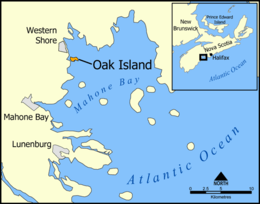Oak Island
 Oak Island, Nova Scotia | |
| Geography | |
|---|---|
| Location | Nova Scotia, Canada |
| Coordinates | 44°30′46.9″N 64°17′17.9″W / 44.513028°N 64.288306°WCoordinates: 44°30′46.9″N 64°17′17.9″W / 44.513028°N 64.288306°W |
| Total islands | 1 |
| Area | 57 ha (140 acres) |
| Highest elevation | 11 m (36 ft) |
| Administration | |
|
Canada | |
| Province | Nova Scotia |
| Demographics | |
| Population | 2[1][2] |
Oak Island is a 57-hectare (140-acre) privately owned island in Lunenburg County on the south shore of Nova Scotia, Canada. The tree-covered island is one of about 360 small islands in Mahone Bay and rises to a maximum of 11 metres (36 feet) above sea level. The island is located 200 metres (660 feet) from shore and connected to the mainland by a causeway and gate. The island is best known for various theories about possible buried treasure or historical artifacts, and the associated exploration.
Oak Island
The nearest community is the rural community of Western Shore which faces the island, while the nearest town is Chester. The earliest European residents of the area were French fishermen who, by the 1750s, had built a few houses on the future site of Chester.[3] Following the Expulsion of the Acadians during the Seven Years' War, the British government of Nova Scotia enacted a series of measures to encourage settlement of the area by the European-descended New Englanders.[3] Land was made available to settlers in 1759 through the Shorham grant. Chester was officially founded that same year.[3]
A large part of Oak Island was granted to the Monro, Lynch, Seacombe and Young families around the same time as the establishment of Chester. The first major group of settlers arrived in the Chester area from Massachusetts in 1761. The following year, Oak Island was officially surveyed and divided into 32 four-acre lots.
In the early days of British settlement, the Island was known locally as "Smith's Island," after an early settler of the area named Edward Smith. Cartographer Joseph Frederick Wallet DesBarres renamed the Island "Gloucester Isle" in 1778. Shortly thereafter, the locally used name "Oak Island" was officially adopted for the Island. Early residents included Edward Smith in the 1760s and Anthony Vaughn Sr. in the early 1770s. In 1784, the government made additional land grants, this time to former soldiers, which included parts of Oak Island.[3][4]
In 1965, Robert Dunfield constructed a causeway from the western end of the island to Crandall's Point on the mainland.
Oak Island Tours now owns 78% of the island. The remaining 22% of the island is owned by private parties. There are two permanent homes and two cottages occupied part-time on the island.[5]
The Oak Island mystery
There have been documented treasure hunts, investigations and excavations on Oak Island since the 1850s. There are many theories about what, if anything, might be buried or concealed there. Areas of interest on the island with regard to treasure hunters include a location known as the Money Pit, a formation of boulders called Nolan's Cross, the beach at Smith's Cove, and a triangle-shaped swamp.[6] The Money Pit area has been repeatedly excavated; critics argue that there is no treasure and that the Money Pit is a natural phenomenon.[7]
More than fifty books have been published recounting the island's history and exploring competing theories.[8] Several works of fiction have been based upon the Money Pit, including The Money Pit Mystery, Riptide, The Hand of Robin Squires, and Betrayed: The Legend of Oak Island.
In January 2014, the History Channel aired The Curse of Oak Island,[9][10] a documentary series about a group of modern treasure hunters led and funded by two brothers, Rick and Marty Lagina, who purchased the majority of Oak Island in 2006.[11]
References
- ↑ "David Blankenship". History Channel. Retrieved January 17, 2018.
- ↑ "Dan Blankenship". www.oakislandtreasure.co.uk. Retrieved January 17, 2018.
- 1 2 3 4 DesBrisay, Mather Byles. History of the county of Lunenburg. Toronto: W. Briggs. p. 619. LCCN 01022095. OCLC 04067460.
- ↑ Sora, Steven (1 February 1999). The Lost Treasure of the Knights Templar: Solving the Oak Island Mystery. Simon and Schuster. p. 304. ISBN 0-89281-710-0.
- ↑ "Explore Oak Island Display". Chester Municipal Heritage Society. Archived from the original on 28 May 2016.
- ↑ Whipps, Heather (7 November 2005). "For Sale: Island with Mysterious Money Pit". Live Science. Purch. Retrieved 5 December 2005.
- ↑ Nickell, Joe (March 2000). "The Secrets of Oak Island". Skeptical Inquirer. 24.2.
- ↑ Conlin, Dan (16 October 2009). Pirates of the Atlantic: Robbery, Murder and Mayhem off the Canadian East Coast. Halifax: Formac Publishing Company Limited. p. 86. ISBN 9780887807411.
- ↑ Kenyon, J Douglas (1 February 2016). Missing Connections: Challenging the Consensus. Atlantis Rising. p. 57. ISBN 9780990690429.
- ↑ Joseph, Frank (12 June 2018). Power Places and the Master Builders of Antiquity: Unexplained Mysteries of the Past. Simon and Schuster. p. 63. ISBN 9781591433149.
- ↑ Blouin, Lou (27 June 2016). "Rick and Marty Lagina: The Last Treasure Hunters". MyNorth. Prism Publications. Retrieved 28 August 2018.
External links
- Google. "Satellite image of Oak Island" (Map). Google Maps. Google.
- "The Oak Island Treasure". MMM Group. Archived from the original on Aug 4, 2002.
- Friends of Oak Island Society, successor to Oak Island Tourism Society, focusing on summer tours
- Oak Island Money Pit, Detailed resource covering the money pit's history